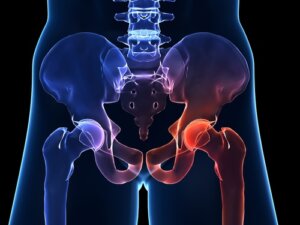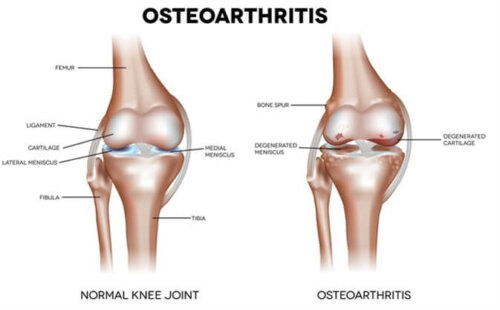Hip Osteoarthritis - Characteristics and Symptoms

Hip osteoarthritis is the wear and tear of the hyaline cartilage present at each end of a joint. This cartilage covers the latter to protect it against rubbing against the others, and also decreases the impact of any loads.
An imbalance due to trauma, genetic defect, and even misuse of the joint decreases its ability to retain water from the cartilage. This results in progressive wear of the joint until the bones become deformed. Thus, it leads to pain and loss of mobility.
Hip osteoarthritis – causes and risk factors

We still ignore the cause of hip osteoarthritis although there are several conditions that lead to its appearance. For example, there’s a genetic factor in which one can inherit osteoarthritis.
Limb malformations are also a predisposing matter, especially in the lower extremities that support body weight. For this reason, being overweight overloads the hips and knees, increasing its possibility of degeneration.
The practice of intense sports as well as certain heavy work can also promote the appearance of osteoarthritis, especially in the lower extremities. Some falls and blows can also lead to its early onset as a fracture could displace the joint.
Generally, this condition manifests in adults over 50-60 years of age. However, it sometimes occurs in young people. These are exceptional cases, though.
Symptoms of hip osteoarthritis
Pain is the most important symptom and it often manifests in the groin, on the thigh, on the inside of the thighs, and even on the knees. The pain is usually tied to activity and mainly relieved by rest. It’s a type of “mechanical pain,” although it’s quite different from inflammatory joint pain.
This is because inflammatory joint pain persists even during periods of physical rest. Also, it may affect both hips. However, usually only one of them is painful.
Another symptom of hip osteoarthritis is the loss of movement, which makes it difficult to carry out typical daily activities.
Both pain and disability are progressive although the evolution is different in each person. Lameness is another symptom of hip osteoarthritis and manifests as a characteristic body rocking when it affects both joints.
Hip osteoarthritis evolves progressively over the years, depending on your level of activity. Many people can lead normal lives if they follow proper treatment.
You may also be interested in Strengthen Cartilage and Ligaments the Natural Way
Diagnosis
Doctors diagnose it by questioning patients about their symptoms and characteristics. In addition, they do an exploration of the hip joint and its movements. This is how most specialists are able to assess the degree of osteoarthritis a person might have.
In addition, they do an X-ray of the hip to confirm the diagnosis. Through it, they’re able to observe the typical changes caused by hip osteoarthritis. This allows them to look for signs of wear and tear in the hip joint and establish a degree of severity.
There’s no direct relationship between the intensity of degeneration and the symptoms. Thus, a heavily worn hip could be painless, even though it might be stiffer, and vice versa.
Read also How to Prevent Cartilage Pain
Treatment

The treatment of osteoarthritis aims to relieve pain and treating functional disability. For this reason, the doctor might choose to prescribe certain drugs to their patient.
- Painkillers are the most widely used medications; they reduce pain and improve joint stiffness. Furthermore, the most common pain reliever is acetaminophen.
- Anti-inflammatories are non-steroidal and used when the pain is more acute.
- Chondroprotectors are constituent substances of articular cartilage and they decrease pain. Glucosamine and chondroitin sulfate are part of this group.
- Interarticular therapy or infiltrations consists of administering anti-inflammatory substances inside the joint. In most cases, they inject glucocorticoids and hyaluronic acid.
Additionally, a physician will recommend adopting a healthier lifestyle and, if necessary, will suggest using some measures to alleviate discomfort – such as the application of cold compresses and physical therapy.
According to Dr. Alexandra Villa-Forte, “the application of cold (ice, for example) can help relieve pain caused by joint inflammation.”
Good habits are the best support for the daily routine
Adopting and maintaining good postural hygiene, avoiding joint overuse or misuse, exercising regularly, taking measures to prevent or reverse obesity, and wearing appropriate footwear are some of the most recommended measures by experts for the well-being of patients with hip osteoarthritis.
Note that the practice of physical activity will vary with the individual. Therefore, people should always consult their own physicians.
All cited sources were thoroughly reviewed by our team to ensure their quality, reliability, currency, and validity. The bibliography of this article was considered reliable and of academic or scientific accuracy.
-
Márquez Arabia, Jaime, & Márquez Arabia, Wiliam. (2014). Artrosis y actividad física Arthrosis and physical activity Arthrose et activité physique. Revista Cubana de Ortopedia y Traumatología.
-
Márquez Arabia J.J., & Márquez Arabia W.H. (2014). Artrosis y actividad física.
-
Guillemain, J.-L. (2013). Rehabilitación de la cadera operada. EMC – Kinesiterapia – Medicina Física. https://doi.org/10.1016/s1293-2965(13)65157-9
This text is provided for informational purposes only and does not replace consultation with a professional. If in doubt, consult your specialist.








